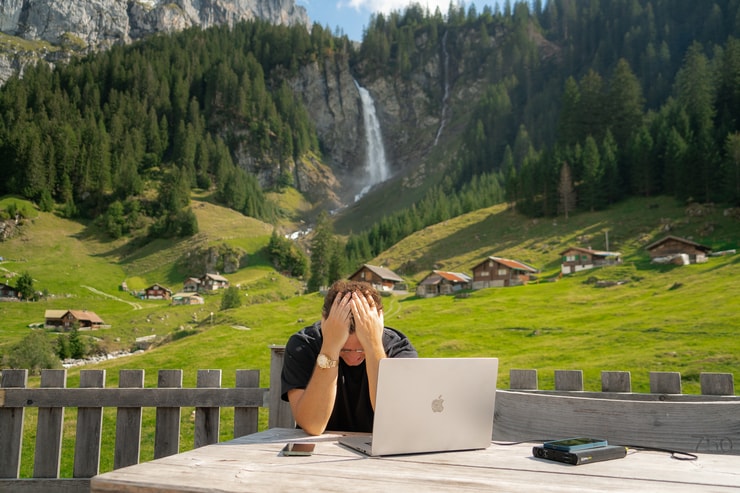I focus on helping new and unprofitable traders develop trading skills to be self-sufficient someday.
More than two dozen of my students have taken what I’ve taught them and used it on their way to becoming seven-figure traders…two of them are now eight-figure traders.
So while I’m focused on helping newer traders…it doesn’t mean I don’t know a thing or two about trading for higher stakes.
After all, I did take $12K and turn it into $7.4 million.
And that’s what I want to do with you today, talk about scaling up.
Specifically when you should do it and when to know it’s the right time.
I see so many traders doing this wrong, and it wipes out weeks and months of progress.
I’m hoping after you read this, that won’t be you.
Table of Contents
The Age of Entitlement

2025 Millionaire Media, LLCWe live in a world where we demand things right away. And if we don’t get it, we moan and complain.
I had no mentors in trading. There was no playbook for me to follow. I had to figure this out through trial and error.
Today’s generation is all about instant gratification.
But you know what?
It’s a good thing.
Why?
Because I want my competition to be slow and lazy.
I want them not to do their homework. I want them to trade with emotion and without a trading plan.
I want the person on the other side of my trade to be naive.
But for whatever reason, these newbie traders want to start making four and five figures daily.
Little did they know my very best students struggled in years one and two of their journey.
You see, making big money doesn’t start in those first few years…it happens much later.
Here’s the fastest and easiest way I know how to scale.
It’s All About Conviction
Jack Kellogg is one of my students and an eight-figure trader. He shares his weekly watchlist and hosts a webinar for Challenge Students.
It’s not uncommon for Jack to make or lose five or six figures in a month.
But that’s not how he started…not at all.
In his first year, he didn’t make any money.
So how does one make this quantum leap?
You need conviction.
Sounds simple enough, right?
It is, actually.
But it requires work.
More Breaking News
- Unpredictable Surge: BNTX Climbs 14%
- Cipher Mining Stock Faces Market Headwinds
- Kinross Gold’s Impressive Comeback
Here’s how to do it…
The Best Traders Become Masters At Pattern Recognition

2025 Millionaire Media, LLCThe other day I had a slick trade in the ticker symbol EVLV.
How did I find the stock out of thousands?
Well, it was a multi-day runner, a pattern I’ve seen work a lot lately. It was an AI play and a strong earnings winner, which were other winning patterns.
And the price action reminded me a lot of AAOI, one of the hottest-performing stocks this year.
I recognized the pattern and took a shot because I felt the risk vs. reward was favorable.
And that’s how the game was played.
Your job is to identify winning patterns…rinse and repeat.
This could be things like:
- Earnings winners
- Sector-related catalysts (most recently, AI has been the hottest)
- Government and policy-related (for example: the push towards EVs)
- Riding the hot hand (ideas from hedge funds, bloggers, and chat rooms that have been hot lately)
- A specific chart pattern (breakouts and mean reversion)
Of course, there’s more, but that’s a good start.
Now, here’s the thing…
The market is dynamic, so some patterns that worked in the past might not work now. And new patterns emerge.
That’s why you must journal your trades. As well as identify the trades that work best in this market.
When Jack wasn’t making money in his first year, he didn’t get discouraged.
Why?
Because he saw other traders making money utilizing specific patterns.
He knew that if he could button up some of his mistakes that he would have a chance to profit in the future.
Once you’ve identified which patterns are working and built your account up, you can slowly start to scale up.
Don’t Make This Mistake

2025 Millionaire Media, LLCOne thing I see is traders trying to scale up too quickly.
For example, if you’re used to risking $100 on a trade, and now you want to risk $200…well, guess what?
You’ve doubled the amount you were used to risking.
Does that make sense?
Not at all.
It takes time to adjust to your new risk levels.
Instead of risking $200, risk $120. That’s a 20% bump.
Eventually, you get to a level of feeling uncomfortable.
Once you get to the point where you are more concerned about the PnL and not the actual trade, you know you’ve scaled too much.
You should feel slightly uncomfortable, but not to the point where you can’t make good decisions because you’re worried about the PnL.
Scaling should happen naturally. You should have so much confidence in the setups you’re taking that you should want to increase your size.
In addition, you want to be scaling when trading better and have profits. Trying to scale from behind can be challenging and could mess up your psychology.
You must prove yourself with consistent results before deciding it’s time to scale up.
Are You Ready To Step It Up?

2025 Millionaire Media, LLCImagine getting insights and training from millionaire traders…do you think that would help you along your journey?
Watching and listening to traders who have climbed the mountain you want to climb can be inspiring but also make things REAL.
You see, a lot of people talk about wanting to make it as a trader. But very few have an actual plan of attack.
Every day my team and I are putting together live training classes aimed at helping new traders achieve their goals.
We bring these live training classes to you at zero cost.
All you have to do is show up.





Leave a reply